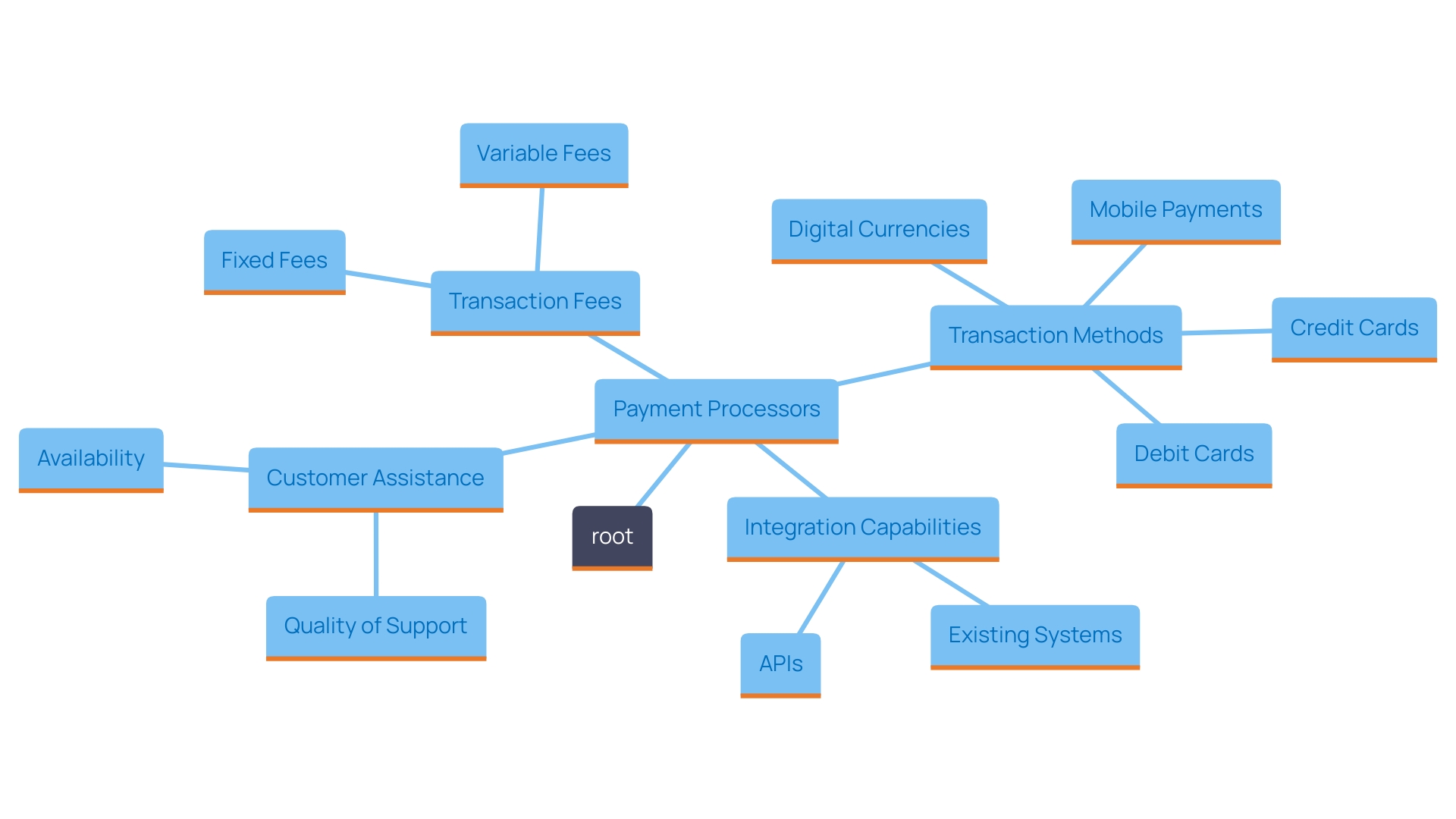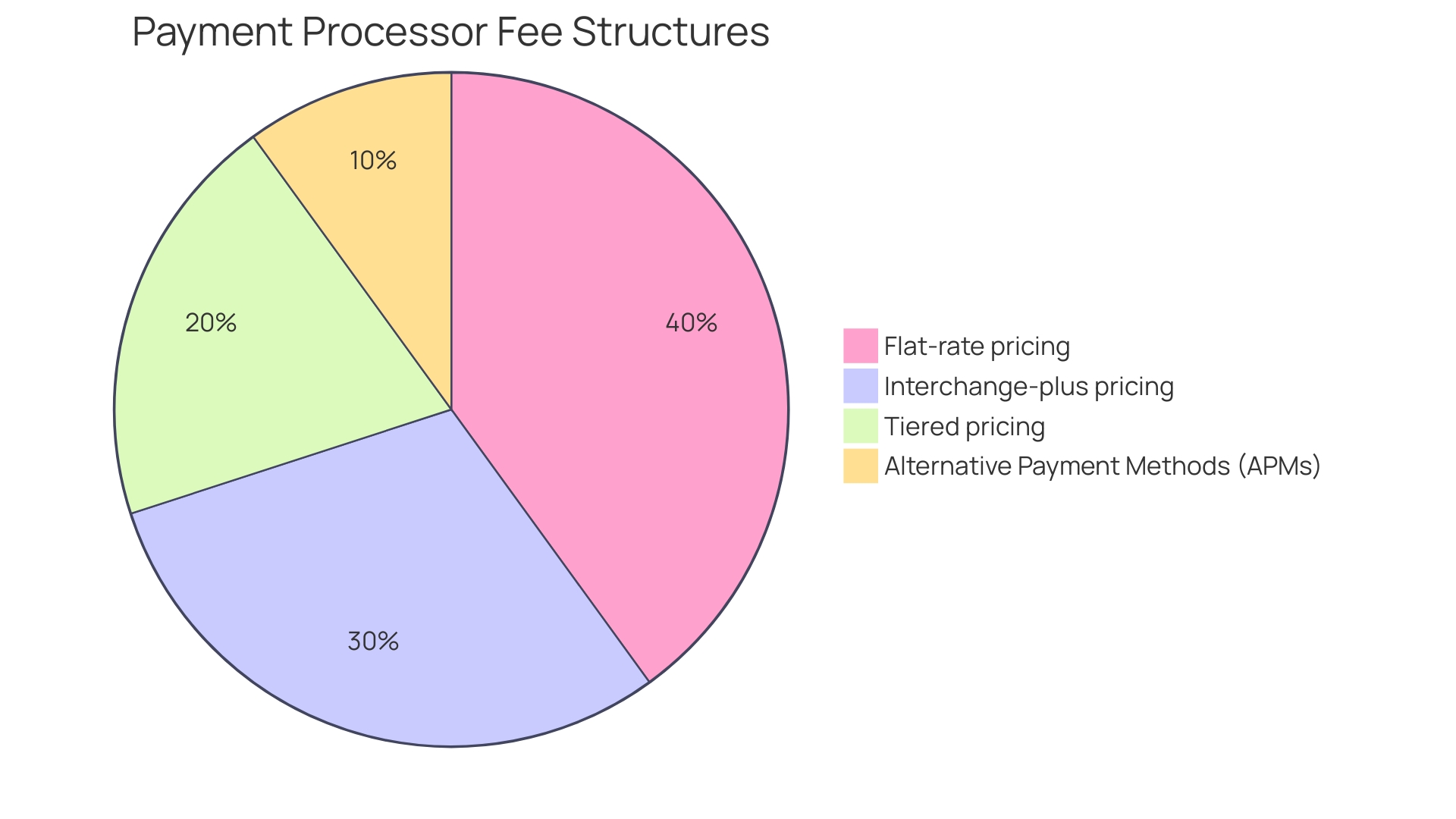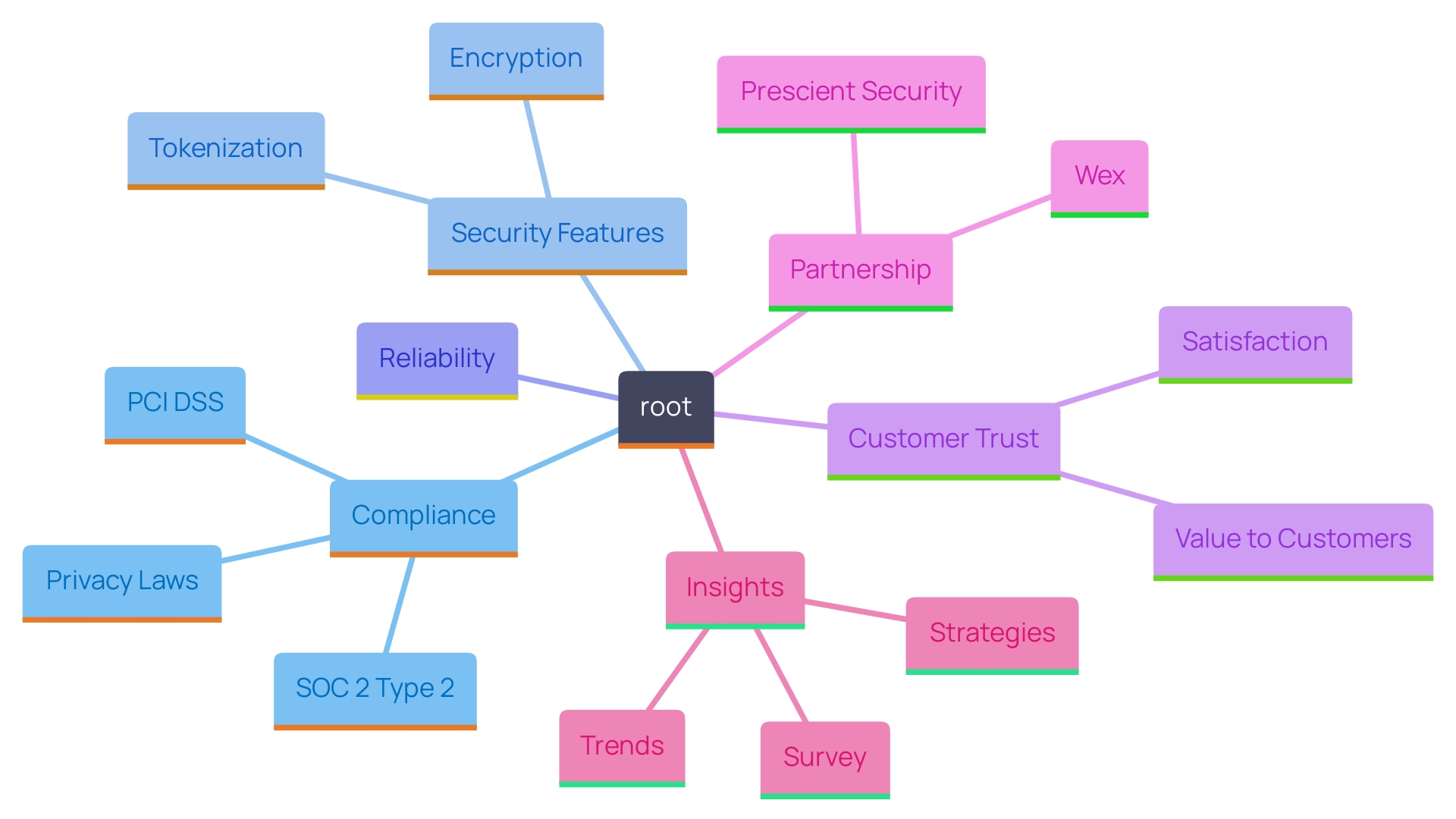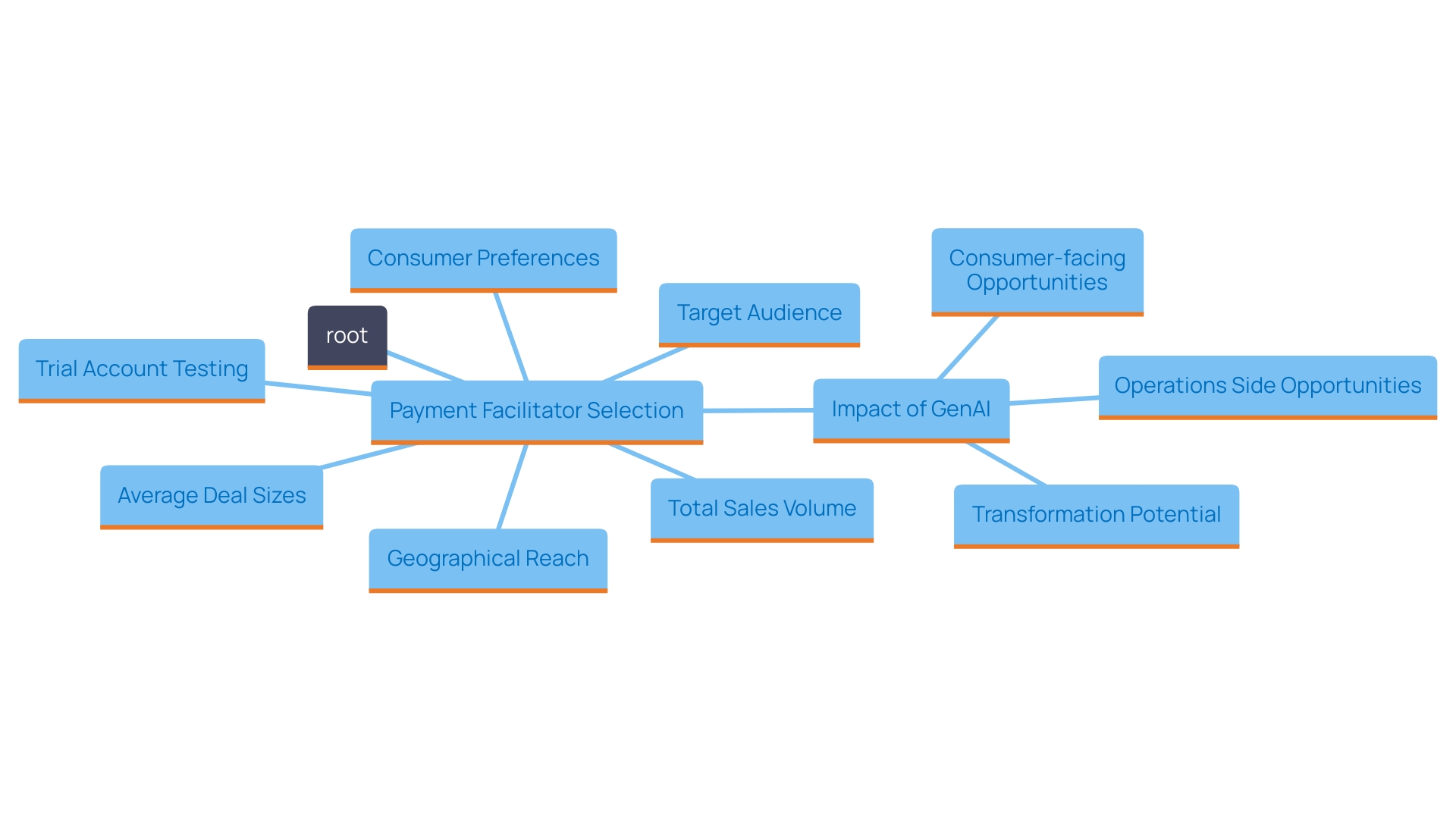Introduction
In an increasingly digital marketplace, the choice of a payment processor can make or break a business. As consumer preferences shift towards diverse and secure payment options, companies must navigate a complex landscape of fees, integration capabilities, and security features. Understanding the nuances of various payment processing solutions is essential for enhancing operational efficiency and customer satisfaction.
This article delves into the key factors to consider when comparing payment processors, from fee structures and pricing models to the vital aspects of security and reliability. By exploring these critical elements, businesses can make informed decisions that not only align with their financial goals but also foster lasting customer relationships in a competitive e-commerce environment.
Key Factors to Compare in Payment Processors
When assessing payment processors, organizations should carefully evaluate several critical factors that can significantly influence their operations. Transaction fees represent one of the most important considerations, as these fees can vary widely among providers. It's essential to break down the costs into fixed fees as well as variable charges based on transaction volume. A comprehensive analysis of these expenses can help businesses choose a provider that aligns with their financial goals.
The range of transaction methods supported is equally vital. In today's digital environment, processors should not only enable credit and debit card operations but also adopt mobile methods and even digital currencies. This variety in transaction options can improve customer satisfaction and promote higher conversion rates.
Integration capabilities must also be a top priority. A seamless connection with existing systems, such as e-commerce platforms or accounting software, is crucial for smooth operations. The ability to integrate easily can significantly reduce friction in the transaction process, leading to better user experiences.
Moreover, companies should evaluate the quality of customer assistance that each transaction facilitator provides. Quick and effective assistance can play a pivotal role in resolving potential issues and minimizing downtime, which is essential for maintaining a reliable e-commerce presence. As noted in industry discussions, organizations that prioritize customer-centric strategies, like those involving comprehensive support systems, tend to foster stronger relationships with their clients.
In a swiftly changing marketplace where buyers progressively anticipate tailored experiences, the selection of a transaction facilitator can significantly affect how companies interact with their clientele. As highlighted in recent surveys, over 90% of consumers have utilized some form of digital payment, indicating a shift in payment preferences that companies must accommodate. By focusing on these key factors, companies can enhance their operational efficiency and customer satisfaction in the competitive world of e-commerce.

Fee Structures and Pricing Models
Payment processors offer a variety of fee structures that can greatly influence an organization's bottom line. Among these, flat-rate pricing stands out for its simplicity, allowing companies to plan their budgets effectively with a consistent percentage charged per occurrence, regardless of the card type. This predictability is especially attractive for companies with consistent activity levels.
On the other hand, interchange-plus pricing offers a more transparent breakdown of costs. By isolating interchange charges from the processor’s markup, this model allows companies to understand precisely what they are paying for each exchange. This clarity can be especially beneficial for high-volume merchants, as it often results in lower overall costs compared to flat-rate structures.
Conversely, tiered pricing can introduce unpredictability into cost calculations. This model classifies activities into various levels, each with its own rates, making it challenging for businesses to predict expenses accurately. Such variability can complicate financial planning and necessitate a more in-depth analysis of transaction patterns.
The emergence of local alternative transaction methods (APMs) also plays a crucial role in this landscape. As companies explore options beyond traditional credit card processors, APMs often provide more cost-efficient solutions. For instance, in markets such as Indonesia, GoPay is preferred due to its reduced charges, while WeChat Pay in China provides not only cost-effectiveness but also a well-known experience for users. With over 500 APMs now available globally, integrating these methods can enhance customer satisfaction while optimizing costs.
Grasping these fee frameworks is crucial for e-commerce enterprises aiming to synchronize their processing selections with their financial objectives and spending behaviors. As transaction orchestration involves, assessing the effectiveness and efficiency of the selected financial service provider becomes increasingly essential for maintaining a competitive advantage.

Security and Reliability Features
Security remains a critical consideration in transaction processing, especially regarding international dealings. Companies must prioritize systems that comply with PCI DSS (Payment Card Industry Data Security Standards), as adherence to these standards significantly enhances customer data protection. A report from WorldPay highlights that consumers today have more transaction choices than ever, shaping the financial landscape and making security an essential element for customer trust.
To bolster security, features such as tokenization and encryption are essential. Tokenization replaces sensitive data elements with non-sensitive equivalents, making it nearly impossible for unauthorized parties to access the original information. Encryption, on the other hand, scrambles data, ensuring that even if it is intercepted, it remains unreadable. Companies like Evervault demonstrate that best-in-class security is achievable through innovative methodologies while remaining compliant with stringent regulations.
Reliability is equally important; businesses should seek systems with high uptime rates and robust backup solutions to mitigate the risk of service disruptions. In fact, the fast-evolving payments industry is entering a decoupled era where convenience and reliability will become key differentiators. The history of a payment system in handling fraud and chargebacks further illustrates its reliability. Notably, the U.S. 'Merchant Services Satisfaction Study indicates that data security and protection are among the top factors influencing merchant satisfaction, underscoring the need for thorough research and comparison to identify providers that excel in these areas.'.
In a competitive environment, financial service providers are being urged to provide improved convenience, affordability, and security. The effective management of risk is no longer just about preventing threats; it is also about enabling growth and innovation. This shift emphasizes the significance of choosing a financial transaction system that not only complies with existing security protocols but is also flexible enough to tackle future challenges.

Choosing the Right Payment Processor for Your Business
Selecting the appropriate payment facilitator is an essential choice that depends on a comprehensive grasp of your enterprise's unique needs and goals. Crucial elements comprise the target audience, average deal sizes, and total sales volume. Understanding these elements will help inform your selection process, especially if you aim to reach a global audience.
The geographical reach of the system is especially vital for companies aiming to grow globally. A unit with a robust international network can facilitate smoother transactions across borders, which is vital in today’s interconnected economy.
A practical approach to this selection involves utilizing trial accounts from various providers. This hands-on testing can reveal key insights into each processor's user interface, ease of integration, and the responsiveness of their customer service. As the financial transaction environment evolves, driven by innovations such as generative artificial intelligence (GenAI), the need for a responsive and adaptable system becomes increasingly important. GenAI is transforming how transactions are processed, offering personalized experiences and operational efficiencies that can enhance business growth.
Furthermore, consumer preferences are changing, with a growing desire for various transaction methods. According to the 9th edition of WorldPay's Global Payments Report, consumer choices are influencing trends in the transaction landscape. By adapting to different transaction options, companies can not only enhance customer contentment but also bolster their cash flow and overall financial well-being.
Ultimately, the ideal payment processor will do more than just facilitate transactions; it will elevate the customer experience and contribute to long-term business success.

Conclusion
In the competitive landscape of e-commerce, the selection of a payment processor is pivotal for optimizing both operational efficiency and customer satisfaction. Key factors such as transaction fees, the range of supported payment methods, and integration capabilities play a significant role in determining the right fit for a business. A thorough evaluation of these elements ensures that companies can align their payment processing choices with their financial objectives and customer expectations.
Understanding various fee structures, from flat-rate to interchange-plus pricing, is essential for effective financial planning. Each model presents distinct advantages and challenges, emphasizing the need for businesses to analyze their transaction patterns and volume carefully. The growing prominence of alternative payment methods further underscores the importance of adaptability in payment processing strategies, allowing businesses to cater to diverse consumer preferences while optimizing costs.
Security and reliability cannot be overlooked, particularly in an era where consumer trust hinges on data protection. Compliance with industry standards such as PCI DSS, alongside advanced security features like tokenization and encryption, is vital for safeguarding sensitive information. Additionally, a processor’s track record in managing fraud and ensuring uptime is crucial for maintaining robust service continuity.
Ultimately, selecting the right payment processor is not merely about transactional capability; it is about enhancing the overall customer experience and driving long-term business success. By focusing on the specific needs of the business and leveraging innovative solutions, companies can position themselves to thrive in an ever-evolving digital marketplace.





